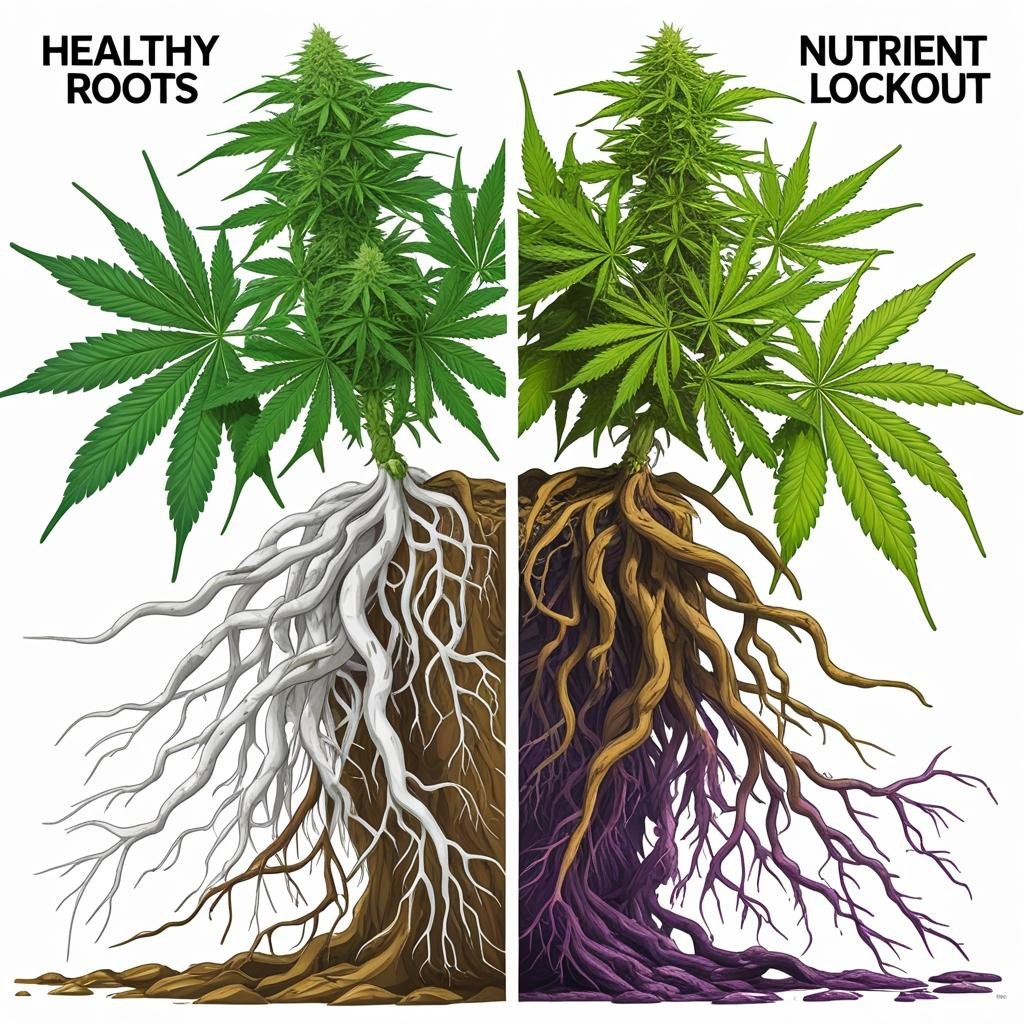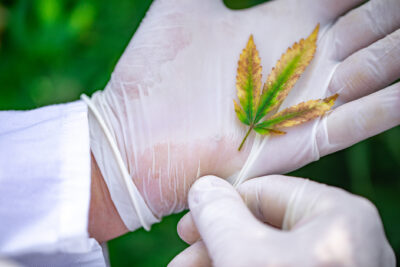Cultivators often notice changes in their marijuana plants’ leaves as a first clue that something is wrong. One of the most common and worrying symptoms is cannabis leaf curl down, also known as clawing.
In this condition, leaves bend down at the tips or along the edges, sometimes forming a claw shape. Understanding what causes cannabis leaf curl, knowing the solutions, and learning how to prevent it can protect your harvest and keep your plants healthy from seedling to harvest.
Table of Contents
What Is Cannabis Leaf Curl Down?
Cannabis leaf curl down happens when leaves fold, twist, or droop in an unnatural downward direction. Moderate downward curling can occur briefly during growth spurts, but severe and ongoing curling signals deeper trouble.
The entire leaf may look heavy, thick, or stiff, and in some cases, you’ll see claw-shaped tips that point down but remain green. This is distinct from wilting, where the leaf droops along the entire petiole and turns limp, often becoming pale or dried out.
The curling leaf symptom is sometimes called “the claw” because the end of the leaf bends down sharply, making the leaf look almost like a raptor’s talon or claw. This issue can develop early or late in the growing process, but it is particularly common during or after the vegetative stage, when the cannabis plant’s metabolism steps up and nutrient needs shift.
Why Do Marijuana Leaves Curl Down?
The cannabis leaf curl down results from plant stress. That stress might relate to water, fertilizer, environment, or pests. Getting to the root of the problem means looking at every part of the growing setup, from soil health to lighting.
Overwatering
The most common cause of downward curl in cannabis is overwatering. Roots need access to oxygen from air trapped in the growing medium. When roots stay wet for too long, they start to suffocate, and the plant struggles to move water through its tissues. In response, leaves curl down and the plant looks droopy or heavy.
Overwatering does not always mean too much water at a single time. Instead, it usually means watering too often, not giving the roots a chance to breathe between waterings.
Even in hydroponics, poor drainage or poorly-aerated systems create the same result. Soggy soil is the enemy of cannabis roots and always increases the risk of rot and root disease.
Nitrogen Toxicity
Marijuana needs nitrogen, but too much can lead to leaf curl. Excess nitrogen is a key cause of the claw.
Leaves exposed to high levels of nitrogen become dark green, sometimes almost blue, and then start to curl at the tip and edges. Plants will look lush at first, but growth slows and bud development suffers.
Nitrogen toxicity develops when using fertilizer with high N values during late vegetative or early flowering stages. Many all-purpose fertilizers or over-use of grow-oriented nutrients cause this problem.
Environmental Stress
High temperatures, humidity swings, and poor airflow can cause downward leaf curl in cannabis plants. If the environment is too hot, marijuana plants try to conserve water by limiting leaf surface area, and downward curling helps with that.
In dry or overly humid conditions, water movement in the plant becomes unbalanced, again leading to curling or drooping.
Low humidity and high heat often accelerate transpiration, making the leaves curl or claw. Similarly, cold roots from sitting water cause the plant to draw water upward, disrupting normal leaf structure.
Root Problems
Anything that harms the roots, be it pathogens, compacted medium, or poor drainage, can trigger cannabis leaf curl. Root rot, in particular, is a risk after periods of overwatering or excessive organic buildup.
Root-bound plants—where the roots grow in tight circles inside the pot—also show signs of stress, including downward leaf curl and patchy, stunted growth.

Overfeeding
Overly strong nutrient solutions can cause salt buildup in the soil or hydroponic reservoir. Accumulated salts interfere with the roots’ ability to absorb water and nutrients. In response, the leaves twist, bend, or curl down. Too high a dose of fertilizer, especially during flowering, makes leaf tips brown or die back, with the rest of the leaf often curling under or forming a rigid claw.
Underfeeding and Deficiencies
While rare, severe potassium and magnesium deficiencies can cause drooping or downward curl along the leaf, especially if the plant is growing quickly.
Young leaves may crumple or appear misshapen, and older leaves may twist. Magnesium deficiency is often seen as yellow between the veins of the leaf, followed by droop or curl.
How to Diagnose Cannabis Leaf Curl Down
If you notice leaves curling down, the best approach is to check the most likely sources first. Start by feeling the medium.
Is the soil waterlogged and heavy?
Does it dry out quickly between waterings?
Does it smell sour or rotten near the base of the plant?
Look for dark green leaves, brown tips, or slowed growth, each of which offers another clue.
Walk through your recent nutrient routine. Did you use more fertilizer than usual, or was there a change in formula? Did you use a heavy dose of nitrogen near or after switching to flower? Consider whether there’s been a sudden change in the grow room—new lights, heat, fans, or a move in location.
Inspect roots if possible. Healthy roots are bright white and smell fresh. Brown, slimy roots are a sign of root rot or suffocation. Check for insects or fungus gnats, both of which can signal decaying organic material in a wet medium.
Solutions to Cannabis Leaf Curl Down
Once you’ve identified the likely source of the curling, you can begin correcting it for a faster recovery. Recovery takes time; curled leaves may not flatten fully but new growth should appear normal.
Correct Overwatering
Allow the soil or medium to dry out before watering again. If your pot is small, consider transplanting the plant to a larger container to prevent root crowding. Improve drainage with perlite, coco, or coarse sand, and never let pots sit in standing water. Water only when the top inch or two of soil feels dry to the touch.
In hydro configurations, increase oxygen in the reservoir by using a more powerful air pump. Clean out any accumulated organic waste and ensure all roots get plenty of fresh air.
Reduce Nitrogen Toxicity
If nitrogen toxicity is to blame, lower the amount of feed given. Switch to a low-nitrogen bloom formula during flowering. If leaves are severely curled and dark green, flush the medium with pH-balanced water to remove excess nutrients.
Avoid using high-nitrogen formulas after the first few weeks of growth or when the first signs of flowers appear.
Leaf color should fade back to normal green, and new leaves should look healthier within days or weeks as long as nitrogen stays in balance.
Address Environmental Stress
Control room temperature, aiming for twenty to twenty-six degrees Celsius during the day, and drop by a few degrees at night. Avoid placing plants in direct airflow from fans, which can dry out or stress leaves, and keep relative humidity between forty and sixty percent.
Monitor environmental changes. Ventilation is key—ensure old, stale air is removed and replaced with fresh air several times per hour.
Fix Root Problems
If you suspect root rot, remove dead roots and repot into fresh, well-draining medium. Rinse the roots in gentle, diluted hydrogen peroxide if rot is moderately advanced, then allow to air dry before watering again.
A root-bound marijuana plant needs a bigger container. Repot carefully without breaking up too much of the root ball, and water lightly for the first few days to reduce shock.
Address Overfeeding
Flush the growing medium with clean, pH-balanced water. Give enough water to run out the bottom of the container, washing away excess salts. Resume feeding at half-strength once new growth is healthy.
Keep records so that dosing mistakes are not repeated. For hydroponics, change the reservoir and replace with a lighter mix.
Treat Nutrient Deficiencies
If a deficiency is confirmed (like magnesium), supplement with a suitable solution, such as a calcium-magnesium product. Only add nutrients specific to the problem, and avoid guessing with multi-nutrient products. Deficiencies often show alongside pH problems, so confirm your pH is in the correct range.
Prevention Strategies for Cannabis Leaf Curl Down
Catching the early warning signs before leaves start to curl down lets you address problems before they get serious. Prevention is simpler than curing sick plants.
- Water only when the growing medium feels dry at least a couple of inches below the surface.
- Use breathable pots and good-quality soil loaded with perlite or other aeration aids.
- Begin with half-strength nutrient solutions and increase only if plants show a need.
- Tailor your fertilizer to plant stage—more nitrogen when young, less when flowering.
- Keep the growing space within the ideal range of temperature and humidity, and always provide active ventilation.
- Monitor root health by checking drainage and occasionally inspecting roots for color and scent.
- Check and adjust pH at every feeding, using a suitable meter or testing drops.
- Keep a daily grow log detailing watering, feeding, temperature, and any visual changes.
If your plants grow in coco or hydroponics, add a calcium-magnesium supplement to avoid deficiencies. In soil, supplement only if the plant shows clear signs of magnesium shortfall.
The Implications of Leaf Curl for Plant Health
While curled leaves can recover if caught early, prolonged stress will reduce plant health and lower yields. Photosynthesis drops, growth slows, and buds fail to swell to their potential size. During the flowering period, issues like clawing may decrease trichome production and aroma, limiting both quality and potency.
Cannabis plants depend on healthy leaves to generate the energy needed for strong growth and heavy flowers. A quick response protects plant health.
Troubleshooting by Growth Stage
Cannabis can show downward curling in both the vegetative and flowering stages, but the cause and solution may shift depending on timing.
In the vegetative stage, overwatering, environmental factors, and excess nitrogen drive most curling. The plant is mostly focused on root and leaf production, so correcting watering and feed strength usually creates fast recovery.
During flowering, cannabis is more sensitive to overfeeding, especially with nitrogen and phosphorus. If leaves begin to curl down once buds form, focus on reducing fertilizer strength, flushing the medium, and improving environmental stability.
Seedlings are prone to overwatering and excess nutrients—many new growers use too much fertilizer too early, leading to curled juvenile leaves and stunted growth. Use only water with the right pH for seedlings.
When to Take Drastic Measures
If leaves curl down and do not recover after correcting possible causes, assess plant health overall. Wilting, browning, and loss of new growth may require removing the affected plant to protect the rest of the crop from pathogens or pests. Do so carefully to avoid spreading problems.
Changing the medium, repotting, or even taking healthy clones from an affected plant offers a last chance for recovery if nothing else works.
Conclusion
Cannabis leaf curl down is one of the most noticeable signs that something is wrong in a marijuana grow. The most common causes are overwatering, excess nitrogen, environmental stresses, root issues, and overfeeding—but all can be corrected with careful observation and simple changes.
Respond quickly at the first sign of curling, find the root of the problem, and monitor new growth for signs of recovery. By maintaining consistent watering, tailored feeding, sound environmental control, and healthy root systems, you can avoid leaf curl and enjoy a healthy, productive cannabis crop.
Consistency, patience, and close attention remain the most powerful tools in any grower’s kit.

